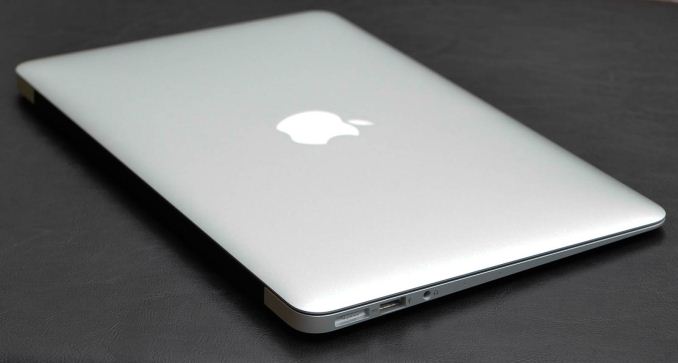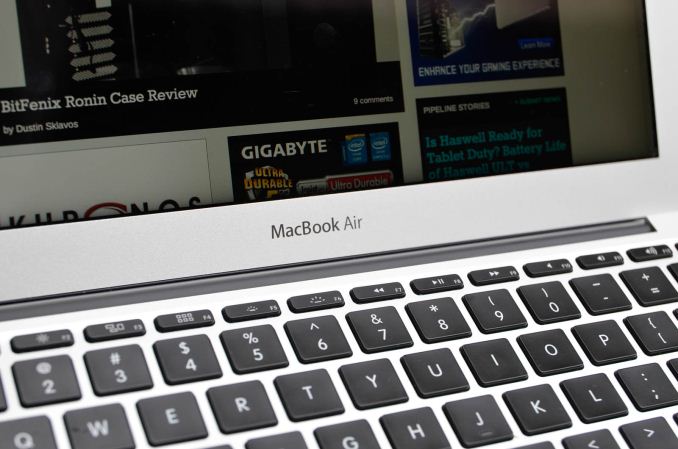The 2013 MacBook Air Review (11-inch)
by Vivek Gowri on August 9, 2013 1:45 AM ESTI come away from the 11” Air with mixed feelings. The modern silicon and generally better specced 2013 model has turned the 11” Air into a far more well rounded notebook than it has been in the past, at least in base $999 form. Unfortunately, the rest of the picture isn’t as rosy. The chassis and especially the display are starting to show their age, even more so than in the 13” Air, and anyone looking for any kind of performance gain over the previous generation is out of luck. The battery life is awesome, it really changes the way you approach the system, and I still love this form factor, but it’s hard to look at this and not compare it to an Ultrabook with a far better display for the same price.
I know Anand has long said that Macs and PCs don’t get cross shopped that often, but recently I’ve been asked for notebook advice by a lot of people who are completely platform agnostic. With the emphasis on web apps, there’s not much holding a normal consumer to one platform or the other unless they have a specific reason (gaming, media creation, familiarity) to ignore one of them. So when you look at something like Sony’s VAIO Pro 11, with a 1080p IPS 11.6” capacitive multitouch display, roughly similar specs (1.6GHz i5-4200U, 4GB, 128GB PCIe SSD), a half-pound lighter body (1.92lbs) with similar dimensions, and roughly the same price point—$1049 street price at the time of writing—it makes you think.
Sure, you lose some of the niceties you get with the new Air—802.11ac, Thunderbolt, the best touchpad in the world (you can’t find another laptop in the world with that combination of things at any price, at least until the next generation of MacBook Pros come out this fall)—and Windows 8 notebooks have never been able to match the battery life of Apple’s notebook line. Sony claims 7 hours of runtime on the 34Wh battery, though it’s worth noting there’s an optional slice battery that adds an extra 35.2Wh of capacity at the cost of a 0.6 lb weight gain. The real question though, how much of the added features would be worth sacrificing for that display upgrade?
On a more global scale, I feel like this is the end of the line for the current MacBook Air chassis. It’s been around for a handful of years now, and I honestly can’t see Apple keeping it around for another go-around. Particularly given how much smaller the Haswell ULT package is and how much less populated the 2013 Air PCB is relative to its predecessors, a sleeker redesign for Broadwell seems inevitable. I’d love to see them get this closer to or even under under the two pound mark without sacrificing the aluminum chassis, because that would really push the boundaries of mobility. I’d like smaller bezels around the LCD as well, though that is more dictated by the size of the keyboard and trackpad than anything else.
Also, it’s clear that something has to give with regards to the displays. I’m not sure when it’ll happen, but it’d be very odd for Apple to continue iterating a thoroughly modern, bleeding edge computer without changing the five year old display panel at some point. Considering all that Apple has done over the years to push notebook displays, it’d be very out of character for them to not address this issue within the next couple of years, particularly as the internal silicon gets so much more power efficient.
Given where this generation of Apple portables has gone, I think the upcoming MacBook Pros will be very interesting. Apple has really prioritized battery life, and the whispers of no dedicated graphics in either MBP makes things very interesting (if a bit concerning from a performance standpoint). If the 54Wh battery in the Air 13” gets to 11 hours of battery runtime without too much trouble, just imagine what the 74Wh battery in the rMBP13 or the 95Wh battery in the rMBP15 can do with Haswell’s power efficiency, particularly if the updated MBP13 gets a single chip 28W Haswell ULT part with Iris graphics. I get chills just thinking about it.
But in terms of the 11” Air, the main point of comparison that needs to be addressed is the 13” Air. I know I covered this in the intro, but it’s worth revisiting. The 13” is without question the better computer, and if you’re looking to replace a laptop, it’s definitely the way to go. I like the 11” Air as a tablet replacement—I’d rather carry this than my iPad on almost every day of the week (unless I need the built-in LTE). It’s almost impossible to use as a primary system though, the way you can with the larger Air. The difference-maker relative to the 13” Air isn’t the weight, since that’s still quite light at 2.96lbs, but the footprint. While the 11” Air is small enough to fit basically anywhere an iPad can be carried, the 13” is much closer to the size of a real notebook. The fact that I’d be making minimal compromises to carry a real notebook versus the iPad is startling, and if you need the most mobile productivity machine you can get, it’s hard to top this. As we start to see more Haswell-based ultraportables and tablets, particularly when the Haswell ULX (Y-series) parts hit, this might change, but for now I feel pretty comfortable saying that.













139 Comments
View All Comments
ccd2 - Monday, August 12, 2013 - link
It could be that Apple makes for good one stop shopping. Many like myself have issues with the cost of Apple machines, but hardly anyone questions their quality. Many feel that, in part, Microsoft and Google entry into hardware is due to the failure of non apple OEM to offer well executed productsKPOM - Saturday, August 10, 2013 - link
If you travel a lot the 11" Air is a good choice. Try using a 15" or even some 13" notebook in the middle seat on an airplane tray table and you'll see why. The 11" and 13" MacBook Air models have identical internals now.beggerking@yahoo.com - Sunday, August 11, 2013 - link
absolutely no need to be torn between an ipad vs air... just get a Surface PRO!! even the current version beats air with its touchscreen and pen input..the next version with Haswell processor will absolutely replace both ipad and air.
name99 - Sunday, August 11, 2013 - link
For christ's sake. You are committing an even dumber error than Vivek with his repeated reference to "real computer.The salient difference between an iPad and an MBA is not the realness of the computer, it is that they have different input systems, and these different input systems have different strengths.
It would be a simplification, but a justifiable one, to say that the MBA, with its keyboard and trackpad, has a much higher bandwidth input system. That's not quite true --- for certain purposes (making music for example) multi-touch provides a high bandwidth input system. But for MOST purposes, the keyboard provides rapid input of one sort, the trackpad rapid input of another sort. Typing on glass does not match the keyboard speed, and even the with keyboard of a Surface Pro you're missing the fine accuracy and immediacy of a trackpad.
The point is not that one is "better" than the other. That's precisely the sort of stupidity that leads you to create devices like Surface Pro which try to do too many things and do them all badly.
The point is that different is DIFFERENT. Navigating Apple Maps is vastly superior on my iPad to navigating Google Earth on a laptop or my iMac, and while I imagine Apple will do a good job with their UI for Maps on OSX 10.9, my guess is it will not be as good as on the iPad. The task of manipulating the 3D view of a city works really well with the immediacy afforded by a multitouch screen. Music is a similar sort of activity where that sort of immediacy can work well, likewise for some types of art creation.
We're on our first tentative steps to voice UIs, but there are already a few situations where commanding Siri is indeed faster than the alternative ways of getting things done.
MBAs and iPads will coexist for a long time because they do different things, and the way they do those different things is so intrinsic to the way they are shaped that each cannot usefully be morphed into the other. When Vivek says he wants a "real" computer he means that, for certain tasks, he wants the high input bandwidth that an MBA gives him. He's not going to be satisfied by replacing that with a keyboard that's not as good, no trackpad, and apps that are not optimized for this sort of high bandwidth input. And why should he have to? It's easy enough and cheap enough (and getting cheaper every year) to have both.
beggerking@yahoo.com - Sunday, August 11, 2013 - link
a single Surface Pro replaces both. better and cost less.KPOM - Sunday, August 11, 2013 - link
Not really. It's too big and bulky to be used as a tablet, and its screen is even smaller than a MacBook Air. Plus it has only a single USB port. A MacBook Air has two USB ports and a Thunderbolt port.Tablets seem to be settling into the 7-8" range. Where that leaves the 11.6" MacBook Air is a bit uncertain, since a 13" MacBook Air or Ultrabook provides more viewing area. Perhaps the next version will fit in a 12.5" screen. Even as is, however, an 11.6" MacBook Air does provide a better desktop computer experience.
TheinsanegamerN - Sunday, August 11, 2013 - link
surface pro has 2 usb ports. please go and LOOK at one before denouncing it.KPOM - Sunday, August 11, 2013 - link
Not according to this:http://www.microsoft.com/surface/en-us/surface-wit...
Ports Full-size USB 3.0
microSDXC card slot
Headset jack
Mini DisplayPort
Cover port
Site7000 - Sunday, August 11, 2013 - link
Then why doesn't anybody buy them?willstay - Monday, August 12, 2013 - link
I would like to know battery performance with Parallels or VMFusion running Microsoft Outlook connected to Exchange Server in Windows 8 Vs running Windows 8 as base OS.